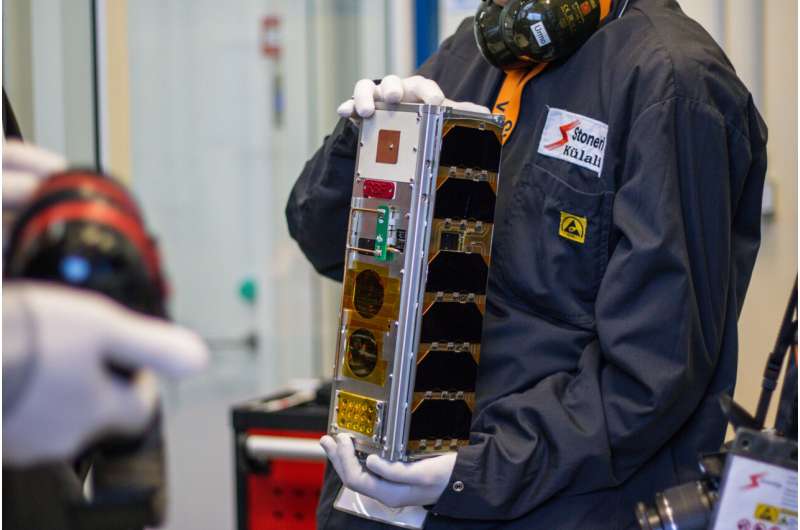
Copernical Team
Large mound structures on Kuiper belt object Arrokoth may have common origin
 A new study led by Southwest Research Institute (SwRI) Planetary Scientist and Associate Vice President Dr. Alan Stern posits that the large, approximately 5-kilometer-long mounds that dominate the appearance of the larger lobe of the pristine Kuiper Belt object Arrokoth are similar enough to suggest a common origin. The SwRI study suggests that these "building blocks" could guide further work o
A new study led by Southwest Research Institute (SwRI) Planetary Scientist and Associate Vice President Dr. Alan Stern posits that the large, approximately 5-kilometer-long mounds that dominate the appearance of the larger lobe of the pristine Kuiper Belt object Arrokoth are similar enough to suggest a common origin. The SwRI study suggests that these "building blocks" could guide further work o Lunar ambitions boost space funding as investment set to reach $33 billion by 2032
 Lunar exploration is the catalyst behind an unprecedented surge in the space exploration sector which saw global government investment rise to an impressive $26 billion during 2023. Ambitious lunar missions are projected to boost investment to nearly $33 billion by 2032, a growth trajectory which underscores lunar exploration's pivotal role in shaping the future of space exploration. The figures
Lunar exploration is the catalyst behind an unprecedented surge in the space exploration sector which saw global government investment rise to an impressive $26 billion during 2023. Ambitious lunar missions are projected to boost investment to nearly $33 billion by 2032, a growth trajectory which underscores lunar exploration's pivotal role in shaping the future of space exploration. The figures SwRI scientists use Webb, Sofia telescopes to observe metallic asteroid
 Southwest Research Institute scientists are using telescopes to observe the asteroid Psyche in the infrared, providing context for NASA's upcoming Psyche mission. Dr. Stephanie Jarmak is using the James Webb Space Telescope (JWST) to look for water signatures on the metallic surface of Psyche, while Dr. Anicia Arredondo is using some of the last data collected by the Stratospheric Observatory fo
Southwest Research Institute scientists are using telescopes to observe the asteroid Psyche in the infrared, providing context for NASA's upcoming Psyche mission. Dr. Stephanie Jarmak is using the James Webb Space Telescope (JWST) to look for water signatures on the metallic surface of Psyche, while Dr. Anicia Arredondo is using some of the last data collected by the Stratospheric Observatory fo US slaps Satellite TV provider with first-ever space debris fine
 US authorities said they have issued a "breakthrough" first-ever fine over space debris, slapping a $150,000 penalty on a TV company that failed to properly dispose of a satellite.
On Monday the Federal Communications Commission (FCC) came down on Dish for "failure to properly deorbit" a satellite called EchoStar-7, in orbit since 2002.
"This marks a first in space debris enforcement by
US authorities said they have issued a "breakthrough" first-ever fine over space debris, slapping a $150,000 penalty on a TV company that failed to properly dispose of a satellite.
On Monday the Federal Communications Commission (FCC) came down on Dish for "failure to properly deorbit" a satellite called EchoStar-7, in orbit since 2002.
"This marks a first in space debris enforcement by China invites Chang'e-8 lunar probe mission global collaboration
 The China National Space Administration (CNSA) is offering opportunities for international cooperation on payloads that will piggyback on the country's Chang'e-8 lunar exploration mission, slated for launch around 2028.
The Chang'e-8 mission is open to all countries and international organizations for collaboration at either mission, system or single-machine levels in order to encourage mo
The China National Space Administration (CNSA) is offering opportunities for international cooperation on payloads that will piggyback on the country's Chang'e-8 lunar exploration mission, slated for launch around 2028.
The Chang'e-8 mission is open to all countries and international organizations for collaboration at either mission, system or single-machine levels in order to encourage mo Space needs better 'parking spots' to stay usable
 Any mission headed to space needs a "parking spot" at its destination. But these parking spots, regions located on orbits, are quickly becoming occupied or more vulnerable to collisions.
Most objects launching to space are satellites, which can travel faster than 4 miles per second in the regions where they park. About 10 times the number of satellites currently in space are expected to la
Any mission headed to space needs a "parking spot" at its destination. But these parking spots, regions located on orbits, are quickly becoming occupied or more vulnerable to collisions.
Most objects launching to space are satellites, which can travel faster than 4 miles per second in the regions where they park. About 10 times the number of satellites currently in space are expected to la Study quantifies satellite brightness, challenges ground-based astronomy
 The ability to have access to the Internet or use a mobile phone anywhere in the world is taken more and more for granted, but the brightness of Internet and telecommunications satellites that enable global communications networks could pose problems for ground-based astronomy. University of Illinois Urbana-Champaign aerospace engineer Siegfried Eggl coordinated an international study confirming
The ability to have access to the Internet or use a mobile phone anywhere in the world is taken more and more for granted, but the brightness of Internet and telecommunications satellites that enable global communications networks could pose problems for ground-based astronomy. University of Illinois Urbana-Champaign aerospace engineer Siegfried Eggl coordinated an international study confirming US slaps TV provider with first-ever space debris fine

US authorities said they have issued a "breakthrough" first-ever fine over space debris, slapping a $150,000 penalty on a TV company that failed to properly dispose of a satellite.
On Monday the Federal Communications Commission (FCC) came down on Dish for "failure to properly deorbit" a satellite called EchoStar-7, in orbit since 2002.
"This marks a first in space debris enforcement by the Commission, which has stepped up its satellite policy efforts," the FCC, which authorizes space-based telecom services, said in a statement.
As the geostationary satellite came to the end of its operational life, Dish had moved it to an altitude lower than the two parties had agreed on, where it "could pose orbital debris concerns," the FCC said.
Estonia's next satellite, largely built by undergrad students, to fly aboard Vega VV23

Estonia's next satellite will fly aboard Europe's Vega VV23 launcher later this week. While largely designed and built by undergraduate students, the shoebox-sized ESTCube-2 has ambitious goals in mind, including surveys of Estonian vegetation and the first successful in-orbit demonstration of "plasma brake" technology.
First spacewalk for Andreas Mogensen

ESA astronaut Andreas Mogensen will venture outside the International Space Station to install a new camera and prepare an experiment for a future upgrade on his first spacewalk on 12 October, starting at 16:00 CEST (15:00 BST).

